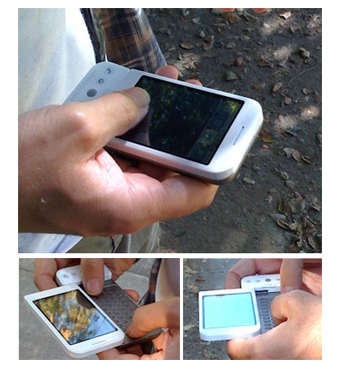 The real power of a Google phone and the Android mobile operating system isn’t just computing power, or search, or advertising, or maps. It’s the ability to connect people, places, and things like never before.
The real power of a Google phone and the Android mobile operating system isn’t just computing power, or search, or advertising, or maps. It’s the ability to connect people, places, and things like never before.
With the introduction Tuesday of the Google phone — dubbed G1 by wireless carrier T-Mobile — we’re starting to see the potential disruption that Google and Android will bring in the coming year or two. It’s even greater than what Apple and the iPhone have already accomplished.
Together, the so-called Google phone and the iPhone are disrupting the mobile industry with innovative, powerful, handy devices, applications, and services. Side by side, the Gphone and the iPhone have their differences but overall compliment one another, not compete with each other.
The iPhone is not unlike Apple, which is known for exquisitely designed hardware, user-friendly software, and a user experience like no other. The iPhone has a consumer, digital lifestyle feel to it, just like Apple products.
The Google phone, on the other hand, is not unlike “PC” in the famed “Mac” vs. “PC” television ads. This is not to say, however, that Google is Microsoft. Far from it.
The G1 — at least from what we’ve seen so far — has a “productivity” air to it, which is expected due to the nature of Google. The Android operating system, and the phone’s hardware, was developed first and foremost to showcase what Google does best — search along with Web applications like Maps, YouTube, Google Reader, Gmail, Calendar.
 Entertainment and gaming is, of course, available on the Google phone, but it doesn’t seem as top-of-mind important as it is on the iPhone, which, as you may recall, is also an iPod.
Entertainment and gaming is, of course, available on the Google phone, but it doesn’t seem as top-of-mind important as it is on the iPhone, which, as you may recall, is also an iPod.
Even the applications Google (or was it T-Mobile?) chose to pre-install on the G1 are utilitarian — ShopSavy helps people with comparative shopping, Ecorio tracks your daily travel and records your carbon footprint, and BreadCrumbz is a step-by-step visual mapping tool and social network. In fact, one of the early strengths of the Gphone is expected to be location-based services and augmented reality applications.
Which brings me to people, places, and things. First off, people have been communicating with each other since the days of smoke signals and cave paintings. This is nothing new to wireless handset makers and the mobile industry.
What is new — or is at least coming over the next year or two — is off the radar of most people. We will use mobile devices like the G1 not just to communicate with each other but to also “talk” with places and things.
It takes a bit to grasp that inanimate places and objects will speak to us. But, as always, technology is advancing quickly and it’s likely that there will soon be microchips and sensors in every object everywhere and many of these could be embedded with Android.
It’s not out of the question that the conference room in your office will relay to your Google phone the day’s schedule. Or, when you walk into the neighborhood book store, it tells you that your favorite author Neal Stephenson’s latest tome “Ananthem” is available in hardcover, digital, and audio formats and, by the way, it’s on sale.
This is not exactly what futurists envisioned. They were onto the concept of “places” and “things” but more like your refrigerator calling your phone to tell you you’re out of milk. When you pass by the local Starbucks it senses your presence and sends a coupon to your phone for a buck off a latte.
The future power of the Google phone — and the iPhone, should Apple take it in this direction — is for the doctor’s office to update your mobile device on future appointments or the medication you are supposed to take before you leave the waiting room. It’s a building telling you about itself, or a restaurant that gives you its history and passes along reviews and stories from its patrons. It’s the information that’s important to you, when you want it, how you want it, and where you want it.
Google is the gatekeeper of our information and knowledge today. More than any other company, it is poised to deliver information to us, no matter if it comes from people, places, or things.
The first Google phone is just the start.

Android is definitely gonna give some competition to iphones…worth watching…